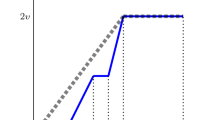Abstract
This paper develops a model of interest group lobbying based on the central premise that such lobbying is fundamentally an exercise in strategic information transmission. Lobbyists typically possess information that legislators do not and, inter alia, such information is relevant to legislators when it concerns the consequences — either policy or political — of supporting one bill rather than another. However, given that the interests of lobbyists do not necessarily coincide with those of legislators, the extent to which a lobbyist is able to persuade a legislator to act in his or her interest is moot. The paper explores the extent to which lobbyists can influence a legislative decision in such a setting; in particular, we are concerned with the incentives for interest groups to acquire costly information and lobby a legislator when there exist other groups that do not share the same interests. Among the results are that a legislator will on average make “better” decisions with lobbying than without, and that the more important is an issue to a special interest group, the more likely is the legislator to make the correct full-information decision.
Similar content being viewed by others
References
Ainsworth (1989) Evaluating interest group influence: the importance of lobbyists. mimeo. University of Minnesota, USA
Austen-Smith D, Wright JR (1990) Competitive lobbying for legislators' votes. Working paper, University of Rochester, USA
Berry JM (1989) The interest group society (2nd ed). Scott Foresman, Gleuview
Bauer RA, Sola Pool, I de, Dexter LA (1963) American business and public policy. Atherton, New York
Bentley AF (1908) The process of government. Cambridge, University Press 1967
Becker GS (1983) A theory of competition among pressure groups for political influence. J Econ 98: 371–400
Bosso CJ (1987) Pesticides and politics: the life-cycle of a public issue. Pittsburgh, Pittsburgh University Press
Campbell A, Converse PE, Miller WE, Stokes DE (1960) The american voter. New York, Wiley
Coughlin, PJ, Mueller, DC, Murrell P (1990) Electoral politics, interest groups, and the size of government. Forthcoming in Economic inquiry
Dahl RA (1961) Who governs? New Haven, Yale University Press
Denzau AT, Munger MC (1986) Legislators and interest groups: how unorganized interests get represented. Am Pol Sci Rev 80: 89–106
Dexter RF (1969) How organizations are represented in Washington. Bobbs-Merrill, Indianapolis
Fenno RF (1978) Home style: house members in their districts. Little, Brown, Boston
Fowler FL, Shaiko RG (1987) The grass roots connection: environmental activists and senate roll calls. Am J Pol Sci 31: 484–510
Gilligan T, Krehbiel K (1989) Asymmetric information and legislative rules with a heterogenous committee. Am J Pol Sci 33: 459–490
Kingdon JW (1973) Congressmen's voting decisions. Harper and Row, New York
Kingdon JW (1988) Ideas, politics and public policies (mimeo), University of Michigan
Matthews DR (1960) U.S. senators and their world. Random House, New York
Mayhew DR Congress; The electoral connection. Yale University Press, New Haven
Milbrath LM (1960) Lobbying as a communication process. Publ Opin Quart, 24: 33–53
Milbrath LM (1963) The washington lobbyists. Rand McNally, Chicago
Miller WE, Stokes D (1963) Constituency influence in congress. Am Pol Sci Rev 57: 45–56
Rothenberg LS (1989) Do interest groups make a difference? Lobbying constituency influence, and public policy? Working paper, University of Rochester
Salisbury RH (1983) Interest groups: toward a new understanding. In: Interest group politics, Cigler AJ, Loomis BA (eds). Washington, Congressional Quarterly Press
Salisbury RH (1984) Interest representation: the dominance of institutions. Am Pol Sci Rev 78: 64–76
Salisbury RH, Heinz JP, Laumann EO, Nelson R (1987) Who works with whom? Interest group alliances and opposition. Am Pol Sci Rev 81: 1217–34
Schlozman KL, Tierney JT (1986) Organized interests and american democracy. Harper and Row, New York
Scott AM, Hunt MA (1966) Congress and lobbies. Chapel Hill, University of Noth Carolina Press
Smith R (1984) Advocacy, interpretation, and influence in the US congress. Am Pol Sci Rev 78: 44–63
Smith, R (1988) Interpretation, explanation and lobbying: interest group influence in the US congress. Paper presented at the annual meeting of the Midwest Political Science Association, Chicago
Smith R (1989) Interpredation, pressure and the stability of interest group influence in the US Congress. Paper presented to the annual meeting of the American Political Science Association, Atlanta, Georgia
Snyder J (1991) On buying legislatures. Econ Pol 3: 93–109
Stokes DE, Miller WE (1962) Party government and the saliency of congress. Publ Opin Quart 26: 531–46
Truman DB (1951) The governmental process (2nd ed). Knopf, New York 1971
Wright JR (1990) Contributions, lobbying, and committee voting in the US House of representatives. Amer Pol Sci Rev 84: 417–438
Zeigler H (1964) Interest groups in American society. Englewood Cliffs, Prentice-Hall
Author information
Authors and Affiliations
Additional information
Herb and Gloria Weiss are indirectly responsible for this paper. Unfortunately, neither they nor the anonymous referees can be held responsible for any errors or omissions the paper might contain.
Rights and permissions
About this article
Cite this article
Austen-Smith, D., Wright, J.R. Competitive lobbying for a legislator's vote. Soc Choice Welfare 9, 229–257 (1992). https://doi.org/10.1007/BF00192880
Received:
Accepted:
Issue Date:
DOI: https://doi.org/10.1007/BF00192880



